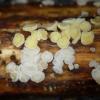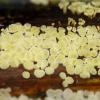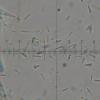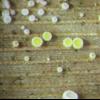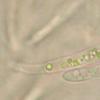
26-12-2025 21:19
Arnold BüschlenPithyella chalaudii Priou. Ist als Bryoparasit in

21-12-2025 09:32
Hello.A tiny ascomycete found embedded in wood in

18-12-2025 21:17
Pol DebaenstThe identification took me to Byssonectria deformi

24-12-2025 17:08
Hulda Caroline HolteHello, I have found this propoloid ascomycete on

21-12-2025 21:32
Pol DebaenstHello, Garden, Burgweg 19, Veurne, BelgiumOn 10/1
[Lachnum cf. reynoutriae] Lachnum sp.
Yannick Mourgues,
26-06-2010 01:06
 Hi.
Hi.Here is another recolt. on Epilobium too with Lachnum reynoutriae.
Macro is same then L. reynoutriar exept the hymenium which is yellow.
Spores 6,7-7,4x1,5-2,1 um with 1guttule at each end.
Asci without croziers, iki+, 35-40x4-5 um.
Paraphyses 70-80x4-5 um, with many guttules, 20-25 um protruding.
Hairs 2-3septate, 70-90x3-4 um with sometimes a slightly widened extremity (l=4-5um)
What do you think about this specie ?
Yannick
Yannick Mourgues,
26-06-2010 01:16

Re:Lachnum sp.
L. brevipilosum even if paraphyses are 20-25 um protruding ?
Stip Helleman,
26-06-2010 01:23
Yannick Mourgues,
26-06-2010 09:27

Re:Lachnum sp.
Hi Stip
VBs were hyaline so it's not that. Unfortunately I haven't made any picture of that.
I don't know what it could be !
Yannick
VBs were hyaline so it's not that. Unfortunately I haven't made any picture of that.
I don't know what it could be !
Yannick
brigitte capoen,
26-06-2010 12:17
Re:Lachnum sp.
Hi Yannick and Stip,
The ''yellowing phenomenon'' that Stip talks about is actually frequent with L. pudicellum but also with other Lachnum species or in other genera such as Crocicreas. The substrate has also partly got the same yellow sulphur colour in that case, which may indicate that the mixed white and yellow specimens are the same species .
Amitiés
Michel
The ''yellowing phenomenon'' that Stip talks about is actually frequent with L. pudicellum but also with other Lachnum species or in other genera such as Crocicreas. The substrate has also partly got the same yellow sulphur colour in that case, which may indicate that the mixed white and yellow specimens are the same species .
Amitiés
Michel
Hans-Otto Baral,
26-06-2010 12:30

Re:Lachnum sp.
Yes, I also think that the yellow colour of the VBs are not a species marker. Therefore I doubt a bit whether the yelow L. morthieri on Phargmites is different from the white L. controversum.
In L. reynoutriae there are no refractive VBs, so I don't know where the yellow pigment is located.
At least we can say that the spore size of this yellow one now better fits L. reynoutriae.
Zotto
In L. reynoutriae there are no refractive VBs, so I don't know where the yellow pigment is located.
At least we can say that the spore size of this yellow one now better fits L. reynoutriae.
Zotto
Yannick Mourgues,
27-06-2010 00:34

Re:Lachnum sp.
Merci à tous !
Yannick
Yannick
